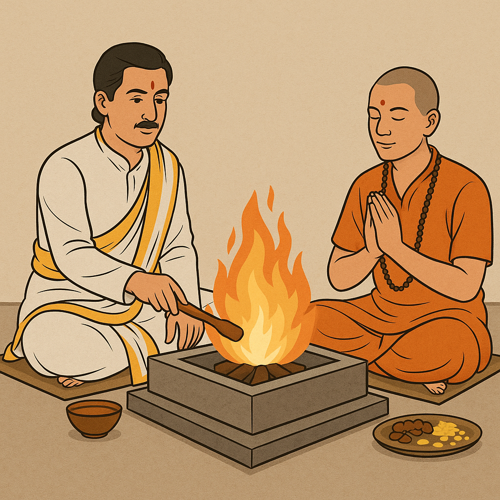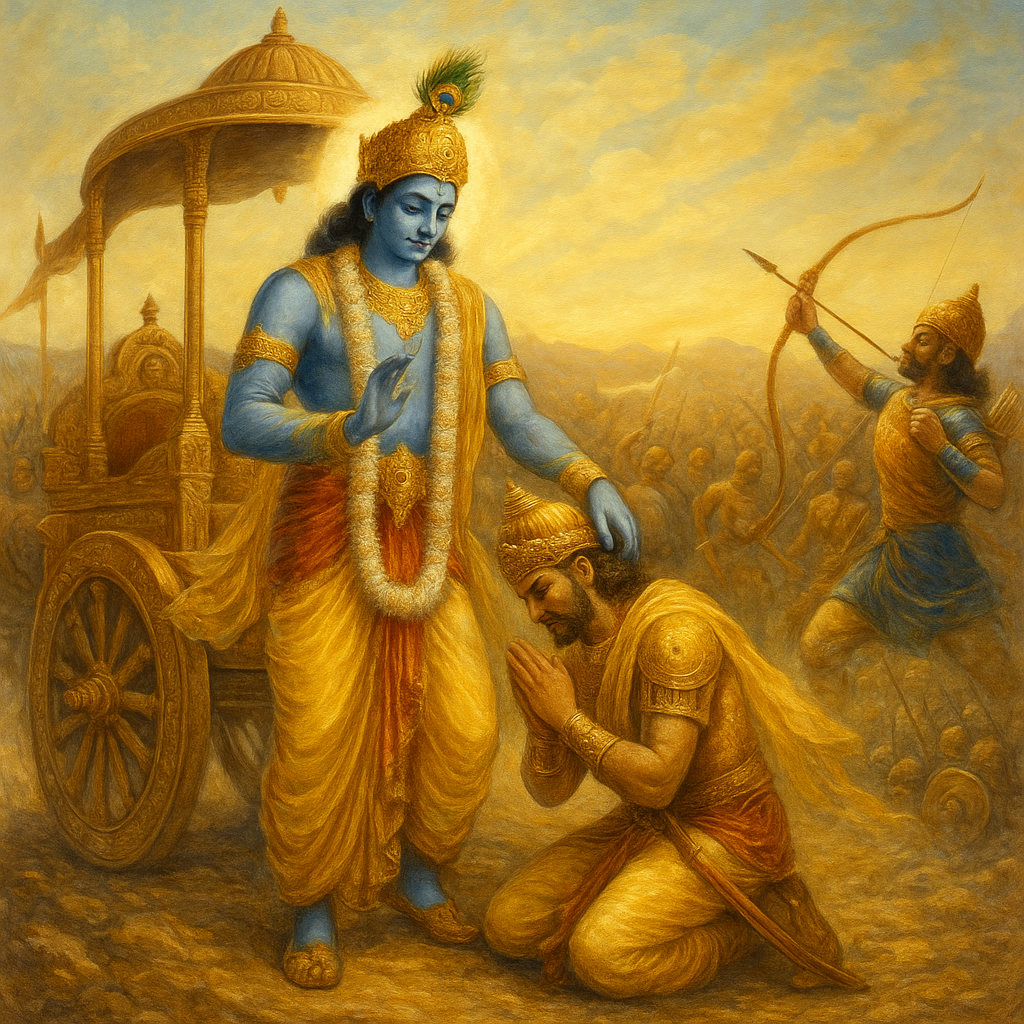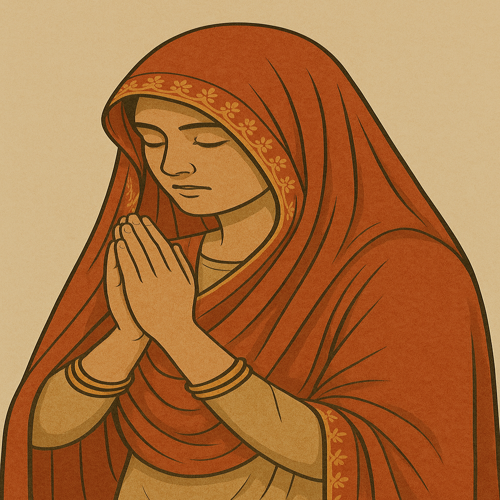The Tilak is not merely a sacred forehead mark in Hinduism, it is the spiritual seal of Sanatan Dharma, a sacred reminder that life’s purpose is higher than worldly existence. From the earliest Vedic period, sages, rishis, and devotees adorned their foreheads with Tilak marks to align themselves with truth (satya), purity (shuddhi), and divine consciousness.
Placed at the Ajna Chakra (third-eye centre), the Tilak awakens inner vision, reminding us that true sight is not with the eyes but with the soul. It proclaims devotion to dharma, declares surrender to the Divine presence, and protects the wearer with spiritual energy. Whether in Hindu temples, festivals, or daily puja rituals, applying Tilak transforms the ordinary act of worship into a profound spiritual connection.
To ask, “Why Tilak?” is to ask: Why do we seek truth? Why do we honour the divine energy within us? For the Tilak is more than a Hindu ritual symbol, it is the bridge between man and God, body and spirit, matter and eternity.
What Is Tilak? Sacred Meaning and Origins in Hindu Tradition
The Tilak is a sacred forehead mark in Hinduism, traditionally applied on the forehead and often made with sandalwood paste (chandan), kumkum (vermilion), vibhuti (sacred ash), or other ritual substances, each carrying its own spiritual vibration and significance. More than an external symbol, it represents the devotee’s inner alignment with divine consciousness and their devotion to dharma.
The practice is as old as the Vedic era. Ancient scriptures describe sages, rishis, and householders alike applying Tilak before performing yajnas (sacrificial rituals), chanting Vedic mantras, or beginning sacred duties. The word Tilak itself comes from Sanskrit, meaning a mark of distinction, a reminder that the wearer has consecrated his or her life to Sanatan Dharma.
Positioned at the space between the eyebrows, the Tilak corresponds with the Ajna Chakra (third-eye centre), the seat of intuition, inner wisdom, and spiritual perception. By sanctifying this powerful energy point with sacred substances, one invokes clarity of thought, discipline of mind, and spiritual focus.
Thus, the Tilak is both an ancient spiritual tradition and a living practice, uniting the body, mind, and soul in harmony with the Supreme consciousness.
Below is a clear, lineage-accurate guide to the major types of Tilak in Hinduism, what each sacred mark looks like, which deity or sampradaya it belongs to, and the deeper spiritual meaning it carries.
Types of Tilak in Hinduism – Deity Associations & Spiritual Meaning
Below is a clear, lineage-accurate guide to the major types of Tilak in Hinduism, what each sacred mark looks like, which deity or sampradaya it belongs to, and the deeper spiritual meaning it carries
1. Vaishnava Tilaks (Urdhva Pundra – Vertical Tilak Marks Devoted to Lord Vishnu)
General Form (Urdhva Pundra):
Two (sometimes three) vertical Tilak lines drawn from the forehead toward the nose bridge. In many Vaishnava traditions, devotees also mark 12 sacred parts of the body. This Tilak signifies surrender and refuge in Lord Vishnu, and alignment with sacred triads such as the three Vedas and the three syllables of Om.
Shri Vaishnava (Iyengar):
Vadakalai:
White “U” with a yellow central line for Goddess Lakshmi.
Tenkalai:
White “Y” with a red central line for Lakshmi.
Both symbolize Sharanagati (surrender) through Lakshmi to Lord Narayana.
Ramanandi:
Two white vertical prongs with a red centre, oriented towards Sita-Ram bhakti.
Madhava (Dvaita):
Two vertical Gopi-Chandan Tilak lines representing Krishna’s feet, with a black central stroke (from yajna ash) and a small dot for Lakshmi/Radha, symbolizing steadfast devotion and daily sacrifice.
Gaudiya (Including ISKCON):
Two vertical lines joined with a Tulasi-leaf shape at the nose bridge, symbolizing service at Krishna’s lotus feet through Tulasi’s grace.
Nimbarka:
Two vertical lines with a black dot between the brows (from Barsana slate), honouring Radha-Krishna together.
Vallabha / Pushtimarga:
A single vertical red line venerating Shri Nathji and Yamuna Devi, emphasizing Pushti (grace) and intimate seva (service).
Swaminarayana (Tilak-Chandlo):
A U-shaped sandalwood Tilak with a red chandlo (dot) representing Bhagwan’s feet and the devotee’s surrender and guru-bhakti.
B. Shaiva Tilaks (Tripundra – Horizontal Vibhuti Lines for Lord Shiva)
Tripundra:
Three horizontal vibhuti (sacred ash) lines drawn across the forehead, often with a central bindu. The Tripundra reminds the wearer of life’s impermanence (all becomes ash), points toward moksha (liberation), and embodies Shiva’s three powers- iccha (will), jnana (knowledge), and kriya (action). It also mirrors the sacred triads mentioned in the Kalagni-Rudra Upanishad.
C. Shakta Marks (Devi / Shakti Traditions)
Kumkum / Bindi Style:
A red kumkum Tilak applied at the Ajna Chakra or as a short vertical/semicircular mark. It signifies Shakti (divine feminine energy), auspiciousness, spiritual protection, and marital prosperity (especially when worn by married women).
D. Smarta & Other Denominations
Smarta:
Depending on the ishta-deva (chosen deity), Smartas may wear sandalwood Tilak (cooling) or vibhuti. This practice is associated with ritual honour and consecration.
Ganapatya:
Often uses red sandal paste (rakta-chandana) in devotion to Lord Ganesha, symbolizing wisdom and the removal of obstacles.
Why These Tilak Forms Matter – A Quick Glance
Vertical (Urdhva Pundra):
Channels awareness upward, expresses devotion to Lord Vishnu, and signifies entry into service at the Lord’s feet.
Horizontal (Tripundra):
Symbolizes renunciation, purification, and stabilizing the mind in Shiva’s remembrance.
Red Bindu / Kumkum:
Represents Shakti, auspicious spiritual energy, and protection of the third-eye centre.
Scriptural Roots of Tilak in Vedas, Upanishads, and Puranas
The practice of applying Tilak in Hinduism is not a cultural invention but a sacred discipline deeply rooted in the Shastras. Across Vedic scriptures, Upanishadic teachings, and Puranic injunctions, the Tilak mark on the forehead is upheld as a seal of sanctity, spiritual identity, and divine remembrance. It is considered an essential part of Sanatan Dharma, symbolizing one’s connection with the Supreme Consciousness and commitment to dharma and devotion.
Vedic Foundations
In the Rig Veda and Atharva Veda, sacred substances such as sandalwood paste (chandan), vibhuti (sacred ash), kumkum (vermilion), and red earth are praised for their purifying powers when applied on the body during Vedic rituals and yajnas. Although the word Tilak itself appears in later texts, the Vedic injunction to sanctify the Ajna Chakra (third-eye centre) located between the eyebrows, laid the foundation for this ancient practice. Applying a Tilak mark here symbolizes aligning the human microcosm (pinda) with the cosmic order (ṛta) and attuning the soul to universal consciousness.
Upanishadic Insights
The Chandogya Upanishad and other Upanishadic texts describe the forehead as the gateway of higher consciousness, directly linked to the Ajna Chakra and the pineal gland. Applying a sacred forehead mark in this region was taught as a powerful way to awaken inner vision, stimulate intuition, and cultivate awareness of Brahman (Supreme Reality). Thus, the Tilak became both an outer ritual symbol and an inner yogic discipline, bridging meditation, mantra chanting, and spiritual awakening.
Puranic Affirmations
The Padma Purana instructs devotees to apply Tilak as a sign of devotion to Lord Vishnu, declaring it a spiritual shield against negative energies and tamasic vibrations.
The Skanda Purana glorifies the Tripundra Tilak worn by Shaivites, teaching that those who apply vibhuti (sacred ash) on their forehead are purified of sins and aligned with Lord Shiva’s grace and liberating energy (moksha).
The Devi Bhagavata Purana associates the red bindu or kumkum Tilak with the blessings of the Divine Mother (Shakti), conferring prosperity, auspiciousness, and marital harmony upon women who wear it.
Energetic and Yogic Significance of Tilak
Beyond scriptural references and ritual practices, the Tilak in Hinduism is also a profound yogic tool that influences the subtle energy system within the human body. Its placement at the Ajna Chakra (third-eye centre) is deeply intentional — this sacred energy point is considered a gateway to intuition, clarity of thought, spiritual perception, and higher consciousness. Applying a Tilak mark on the forehead activates this spiritual centre, transforming a simple ritual into a powerful practice of energy alignment and conscious evolution.
Activation of the Ajna Chakra
When sacred substances such as sandalwood paste (chandan), vibhuti (sacred ash), or kumkum (vermilion) are applied at the midpoint between the eyebrows, they stimulate the pineal gland, regulate the endocrine system, and calm the nervous system.
Ancient yogic texts describe this as awakening drishti (inner sight), allowing the practitioner to look beyond superficial appearances and perceive ultimate truth. This subtle activation of the third-eye chakra deepens meditation, enhances mental clarity, and supports the seeker’s journey towards self-realization.
Preservation of Prana (Life Force)
The Ajna region is the convergence point of the body’s three vital energy channels, ida, pingala, and sushumna nadis. By sealing this sacred spot with a Tilak mark, the spiritual energy (prana) generated through mantra chanting, japa, pranayama, or meditation is conserved rather than dissipated outward.
This retention of prana enhances focus, strengthens concentration, and stabilizes the mind-body connection, empowering practitioners on their yogic and spiritual path.
Protective Vibrations and Energetic Frequencies
Each sacred substance used for Tilak application carries a unique spiritual frequency and therapeutic benefit:
Sandalwood paste (chandan):
Cools the mind, reduces pitta dosha, and soothes fiery emotions.
Vibhuti (sacred ash):
Symbolizes detachment, represents impermanence, and shields against negative vibrations.
Kumkum (vermilion):
Energizes the subtle body with Shakti (divine feminine energy), boosting vitality, confidence, and spiritual strength.
Chandan with camphor:
Enhances mental clarity and inner focus, often used during summer rituals for its cooling and calming properties.
Inner Discipline and Spiritual Awareness
From a yogic perspective, applying a Tilak mark is more than a symbolic act, it is a conscious spiritual discipline that draws the mind inward and aligns awareness with the Self (Atman). Just as pranayama regulates the breath, Tilak application regulates attention, helping practitioners live with mindfulness, purpose, and spiritual awareness.
In this way, the Tilak is not merely a cultural ornament but a spiritual circuit-breaker, one that harmonizes subtle energies, protects consciousness, and guides the soul upward on its path to moksha (liberation).
Cultural and Ritual Importance of Tilak in Hindu Life
In Hindu tradition, the Tilak mark on the forehead is not limited to sages and ascetics, it is a living symbol woven into daily worship, spiritual practice, and sacred ceremonies. Its application reflects devotion to dharma, purity, and alignment with Sanatan culture, making it one of the most recognizable and revered symbols in Hinduism.
Daily Worship and Household Practice
-
Devotees apply Tilak in Hinduism during morning puja, mantra chanting, and evening arti, marking the transition into a sacred state of consciousness.
In many homes, family members receive a Tilak mark before stepping out as a gesture of blessing, protection, and auspiciousness.
Business owners, priests, and householders alike adorn their foreheads with Tilak before opening shops or commencing rituals, seeking divine favour, success, and purity of action. - The daily application of Tilak on the Ajna Chakra also serves as a reminder of the individual’s spiritual purpose and connection to the Supreme Consciousness.
Festivals and Sacred Rites
-
During major Hindu festivals like Diwali, Navratri, Holi, and Ganesh Chaturthi, Tilak is applied to deities (murtis), devotees, and even to ritual tools and objects, signifying sanctification and divine energy activation.
In Raksha Bandhan and Bhai Dooj, sisters apply a kumkum Tilak to their brothers’ foreheads, offering prayers for longevity, health, and spiritual protection.
The Tilak ceremony also marks new beginnings, whether starting a journey, inaugurating a business, or entering a new home, symbolizing auspiciousness and blessings from the Divine.
Sanskaras (Rites of Passage)
In sacred Hindu rites of passage (Samskaras) such as Upanayana (sacred thread ceremony), Vivah (marriage), and Annaprashan (first feeding ceremony), the Tilak is applied to participants, sealing the ritual with purity, protection, and divine grace.
Grooms in Hindu weddings receive Tilak as a sign of welcome, acceptance, and auspiciousness, while brides traditionally wear kumkum or sindoor in the parting of the hair as a symbol of Shakti, marital harmony, and sacred union.
Social and Spiritual Identity
-
The Tilak also serves as a powerful marker of sampradaya (spiritual lineage) and sectarian identity. A Vaishnava Tilak (Urdhva Pundra), a Shaiva Tripundra Tilak, or a Shakta kumkum Tilak instantly reveals one’s devotional path and spiritual alignment.
Beyond sectarian distinctions, the Tilak mark reminds the community that the wearer is anchored in faith, guided by dharma, and dedicated to spiritual growth and liberation.
Through these varied ritual practices, the Tilak in Hinduism transcends being a mere ritual mark, it becomes a cultural signature of sanctity, accompanying a devotee from dawn to dusk, from childhood samskaras to final rites (antyeshti), signifying an unbroken journey of devotion, discipline, and divine connection.
Tilak in Other Religions and Traditions
Though most strongly associated with Tilak in Hinduism, the practice of applying a sacred forehead mark is found in many religions and spiritual traditions around the world, symbolizing protection, sanctity, and divine connection.
Jainism
- Devotees apply sandalwood paste Tilak or saffron Tilak mark on the forehead after prayers in temples.
- The Swastika and Tilak symbol are central sacred emblems in Jainism.
- They represent the four states of existence, the cycle of rebirth, and the ultimate goal of liberation (moksha).
- The Tilak mark also signifies spiritual discipline, devotion, and inner purity.
Buddhism
- In Buddhist traditions (especially in Nepal and Tibet), red or saffron forehead markings are applied during rituals, initiations, and meditation ceremonies.
- These sacred marks symbolize blessing, focus, concentration, and spiritual awakening.
- The markings are often linked with the Ajna Chakra (third-eye centre) and represent the path to higher consciousness.
- Similar to the Tilak in Hinduism, they deepen meditation and align the practitioner with divine awareness.
Christianity
- During Ash Wednesday, Christians receive a cross of sacred ash on the forehead.
- This practice symbolizes remembrance of God, repentance, purification, and humility.
- It mirrors the purpose of the Tilak mark as a sign of faith, devotion, and spiritual identity.
- The forehead remains a sacred point of connection with the divine.
Indigenous Traditions
- Many tribal and indigenous cultures across Africa, the Americas, Asia, and Australia use forehead markings made of clay, ash, or natural pigments.
- These marks serve as protection charms, symbols of initiation, and signs of spiritual alignment with nature and ancestral energy.
- Forehead markings are believed to channel cosmic energy, offering spiritual protection and guidance.
Global Spiritual Practices
- Across civilizations, applying a mark on the forehead has symbolized devotion, sacred identity, spiritual blessings, and divine connection.
- The Hindu Tilak is part of a global spiritual tradition that honours the third-eye chakra as a gateway to higher consciousness.
- This universal practice shows that the Tilak mark transcends religion, serving as a tool for awakening, protection, and inner transformation.
Elevate Your Puja with Rudra Centre’s Sacred Tilak Collection
At Rudra Centre, Tilak is not just a ritual mark, it is a powerful spiritual seal of protection, clarity, and divine grace. Our specially curated collection of fragrant sindoor, kumkum powder, vibhuti (sacred ash), and Tilak essentials is prepared with purity, devotion, and Vedic tradition, ensuring that every application becomes an act of sacred alignment and Ajna Chakra activation.
Kumkum for Shakti worship – Symbolizing divine feminine energy, auspiciousness, and marital prosperity.
Chandan paste for serenity – Cooling, calming, and ideal for Vishnu worship and meditation.
Vibhuti for Lord Shiva – Represents detachment, liberation (moksha), and shields against negative energies.
Multicoloured Tilaks for festivals – Perfect for Navratri, Diwali, Holi, and other Hindu rituals.
Each Tilak product is crafted to invoke positive vibrations, energize the Ajna Chakra, and deepen your connection with the Divine. By choosing Rudra Centre’s Tilak collection, you bring not only auspiciousness into your home but also the blessings of thousands of years of Vedic wisdom preserved through this timeless Hindu tradition.
Explore Rudra Centre’s complete range of Fragrant Sindoor & Tilaks

.jpg)



Comments 0
Leave your thought here